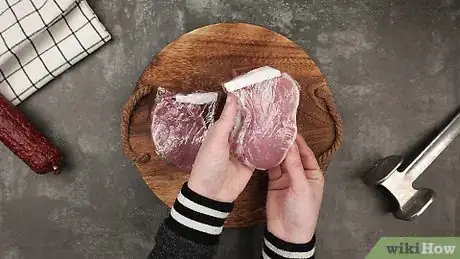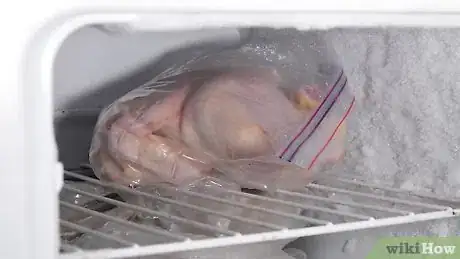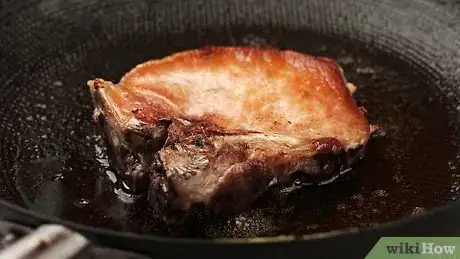This article was co-authored by wikiHow Staff. Our trained team of editors and researchers validate articles for accuracy and comprehensiveness. wikiHow's Content Management Team carefully monitors the work from our editorial staff to ensure that each article is backed by trusted research and meets our high quality standards.
The wikiHow Culinary Team also followed the article's instructions and verified that they work.
This article has been viewed 128,150 times.
Learn more...
If your food budget is strained to the max month after month, save some money by keeping a frozen supply of your favorite cuts of meat and poultry on hand at all times. Because frozen meat lasts for months, stocking up when you find a sale and storing some extra in the freezer will ensure that you’ll always have a backup supply at the ready. Freezing meat at its peak quality will give you the option to make a quick, delicious dinner or to throw together a last-minute feast. So find a bargain, stock up, and get to freezing!
Steps
Preparing the Meat
-
1Store your meat in the refrigerator until it is ready to prepare for freezing. You should store fresh, raw meats in your refrigerator for no more than 2-3 days before freezing them.
- Your refrigerator’s temperature should be kept at 40 degrees F or below at all times to ensure peak freshness and safety of all foods.[1]
- Be ready to prepare the meat quickly so it will stay cold until you freeze it.
-
2Remove the meat from its store packaging and place it on a cutting board. The packaging from the grocery store is not resistant to vapor or moisture, so just discard it.
- Freezing the meat in the store packaging may cause it develop freezer burn more quickly.[2]
Advertisement -
3Cut the meat into individual portions. Use a sharp knife to cut the meat. Remove any unnecessary bones, as they take up freezer space.[3]
- When cutting poultry, keep the deboned meat separate from the meat with bones.[4]
- If you are freezing ground hamburger, you can divide it into 1 pound increments, or form it into quarter pound patties.
- Do not rinse the meat before freezing. It isn’t necessary, and can cause crystallization on the meat when it freezes. If you want to rinse the meat, do it right before cooking.[5]
Wrapping the Meat
-
1Place the meat in the center of a large piece of freezer paper or plastic wrap. If you are using freezer paper, make sure that the paper side is touching the counter and the meat is resting on the waxed side.
- Freezer paper is similar to wax paper. It has a plastic or wax coating on one side, which helps keep meat juices from leaking out. Meat markets and grocery stores use this paper to wrap raw meats in.[6]
- If you can’t find freezer paper, regular wax paper, parchment paper, or even plastic wrap will do.[7]
-
2Pad any bones with small pieces of paper towel so they won’t pierce the wrapping. If any bones pierce the wrap, air will get into the packaging and compromise the quality of the meat.[8]
- Wrap small pieces of paper towel around the bones, then continue to wrap as instructed.
-
3Wrap each piece of meat tightly. Bring the top and bottom of the freezer paper or plastic wrap together over the meat, then fold the freezer paper down towards the meat, making small folds, each 1⁄2 to 1 inch (1.3 to 2.5 cm).[9]
-
4Tuck the ends of the freezer paper or plastic wrap around the package. Smooth to remove as much air as possible. If wrapping in freezer, wax, or parchment paper, use freezer tape to seal the paper securely around the meat.[10]
-
5Wrap the meat again, this time in aluminum foil or a zippered plastic bag. This step is optional, but double-wrapping will help keep air away from the meat and cut down on the risk of freezer burn.[11]
- If storing the meat in a plastic bag, make sure to push all air out of the bag before closing.
- In the plastic bag, place each individual patty or piece of meat between two pieces of freezer paper to help keep them separate when they’re frozen. This will make them easier to quickly grab from the freezer, and it will also speed the thawing process.[12]
-
6Prepare a whole bird for freezing by tucking in its wings, tying its legs and removing the inner organs. Then you can place it into a large plastic freezer bag, or wrap it tightly in freezer paper and tape it closed to seal.[13]
- Store the giblets, heart, and liver separately in a large plastic zip-top bag for freezing.
- If you’re storing the chicken right in a plastic bag, be sure to force all of the air in the bag to escape before zipping it closed.
-
7Label the wrapped meat with the date and its contents in permanent marker. The date lets you know how long each piece of meat has been frozen, and the contents let you know what cut of meat you’re grabbing from the freezer without opening the package.
- Permanent marker works on freezer paper, plastic bags, parchment paper, wax paper, and aluminum foil.
Freezing the Meat
-
1Place the wrapped meat in a freezer set at 0 degrees Fahrenheit or lower. This is the ideal temperature for keeping meats safely frozen. The refrigerator freezer will work just fine.[14]
- Avoid freezing large quantities of meat together, as it will slow down freezing process.
-
2Place the meat in the coldest area of freezer. Separate the pieces or bags to allow the meat to freeze faster. Once the meat is completely frozen, you can rearrange the layout of the freezer.
- If the meat doesn’t freeze quickly enough, ice crystals can form in the meat. These crystals contribute to freezer burn and to the loss of juices while the meat is thawing out.[15]
-
3Avoid opening and closing freezer repeatedly. Your freezer should maintain a temperature of 0 degrees or lower at almost all times in order to keep the meat at its best.
- If you’re only freezing your meat for a short amount of time (a couple of weeks), it’s okay if the freezer’s temperature fluctuates a little from the door opening and closing. Just be sure to eat the meat quickly.
Storing and Refreezing Meat
-
1Store your meat and poultry at a constant temperature of 0 degrees Fahrenheit to maintain their quality. Freezing will keep foods safe almost indefinitely, however the length of time the food is frozen can have an effect on its quality.[16]
- If you want to freeze your meat long-term (over a month), but your refrigerator freezer can’t maintain at least 0 degrees, you may want to consider buying a small, separate freezer for long-term cold storage.[17]
- Well-wrapped meats can be frozen for 6 months to a year.[18]
- Frozen meats can be stored for up to 3 months with almost no breach in quality, but after 3 months, there is a higher chance of developing freezer burn. This is especially true if they are kept in a freezer that doesn’t maintain 0 degrees F.[19]
- Chicken that is wrapped well can be frozen for up to 9 months.[20]
-
2Scrutinize your meat to see if you can detect freezer burn. Look for browning on the meat, smell it for a sharp frozen smell, and look for any ice crystals.
-
3Store cured meats for 1-2 months only. The extra salt in cured meats causes the meat to turn rancid more rapidly, so they must be eaten more quickly.[21]
- This is true for meats like ham and bacon.
-
4Refreeze your refrigerated raw meat safely. If you thaw your meat out and decide not to use it all, you can safely refreeze the raw meat, as long as it has thawed inside of the refrigerator.
- Keep in mind that the quality might not be as good after refreezing the meat, as thawing causes loss of moisture.[22]
-
5Refreeze any cooked meats within 3 to 4 days. Never refreeze anything left outside of the refrigerator for more than 2 hours.[23]
Community Q&A
-
QuestionI want to buy a piece of meat for New Year's, how long will it keep? Until New Year' Day even?
 Community AnswerIt depends on when you buy it and how you are storing it. Meat will only keep for a few days in the refrigerator, but can keep for several months in the freezer and even up to a year if wrapped properly.
Community AnswerIt depends on when you buy it and how you are storing it. Meat will only keep for a few days in the refrigerator, but can keep for several months in the freezer and even up to a year if wrapped properly. -
QuestionCan I freeze meat in aluminum foil?
 Community AnswerI don't recommend it, the last time I did that my aluminum foil stuck to my meat and the flavor did not turn out very well when I cooked it.
Community AnswerI don't recommend it, the last time I did that my aluminum foil stuck to my meat and the flavor did not turn out very well when I cooked it. -
QuestionCan I freeze an uncooked six-pound standing rib roast whole?
 Community AnswerIf you have the space, go for it! Just know it's going to take a long time for it to completely freeze through.
Community AnswerIf you have the space, go for it! Just know it's going to take a long time for it to completely freeze through.
Things You'll Need
- Sharp knife
- Cutting board
- Paper towels
- Freezer paper
- Zip-seal plastic bags
- Plastic wrap
- Wax paper (optional)
- Freezer tape
References
- ↑ http://www.fsis.usda.gov/wps/portal/fsis/topics/food-safety-education/get-answers/food-safety-fact-sheets/safe-food-handling/freezing-and-food-safety/CT_Index
- ↑ http://nchfp.uga.edu/how/freeze/meat.html
- ↑ http://nchfp.uga.edu/how/freeze/meat.html
- ↑ http://www.four-h.purdue.edu/foods/Freezing%20meat%20and%20poultry.htm
- ↑ http://www.fsis.usda.gov/wps/portal/fsis/topics/food-safety-education/get-answers/food-safety-fact-sheets/safe-food-handling/freezing-and-food-safety/CT_Index
- ↑ https://www.thekitchn.com/what-is-freezer-paper-211401
- ↑ http://www.thekitchn.com/freezer-savvy-the-best-way-to-freeze-and-thaw-meat-177355
- ↑ http://www.four-h.purdue.edu/foods/Freezing%20meat%20and%20poultry.htm
- ↑ http://www.four-h.purdue.edu/foods/Freezing%20meat%20and%20poultry.htm
- ↑ http://www.four-h.purdue.edu/foods/Freezing%20meat%20and%20poultry.htm
- ↑ http://www.thekitchn.com/freezer-savvy-the-best-way-to-freeze-and-thaw-meat-177355
- ↑ http://nchfp.uga.edu/how/freeze/meat.html
- ↑ http://www.four-h.purdue.edu/foods/Freezing%20meat%20and%20poultry.htm
- ↑ http://www.fsis.usda.gov/wps/portal/fsis/topics/food-safety-education/get-answers/food-safety-fact-sheets/safe-food-handling/freezing-and-food-safety/CT_Index
- ↑ http://www.four-h.purdue.edu/foods/Freezing%20meat%20and%20poultry.htm
- ↑ http://www.fsis.usda.gov/wps/portal/fsis/topics/food-safety-education/get-answers/food-safety-fact-sheets/safe-food-handling/freezing-and-food-safety/CT_Index
- ↑ http://www.fsis.usda.gov/wps/portal/fsis/topics/food-safety-education/get-answers/food-safety-fact-sheets/safe-food-handling/freezing-and-food-safety/CT_Index
- ↑ http://www.foodsafety.gov/keep/charts/storagetimes.html
- ↑ http://www.thekitchn.com/freezer-savvy-the-best-way-to-freeze-and-thaw-meat-177355
- ↑ http://www.foodsafety.gov/keep/charts/storagetimes.html
- ↑ http://www.foodsafety.gov/keep/charts/storagetimes.html
- ↑ http://www.fsis.usda.gov/wps/portal/fsis/topics/food-safety-education/get-answers/food-safety-fact-sheets/safe-food-handling/freezing-and-food-safety/CT_Index
- ↑ http://www.fsis.usda.gov/wps/portal/fsis/topics/food-safety-education/get-answers/food-safety-fact-sheets/safe-food-handling/freezing-and-food-safety/CT_Index
About This Article
To freeze meat, remove it from its original packaging and cut it into individual portions, removing any bones as you go. Next, place the meat in the center of a large piece of freezer paper and wrap each piece tightly, tucking the ends around each package so air can't get in. Then, label the wrapped meat with the date and its contents in permanent marker and put it in the coldest part of your freezer, which it usually at the very back. For tips on refreezing thawed meat, read on!































































